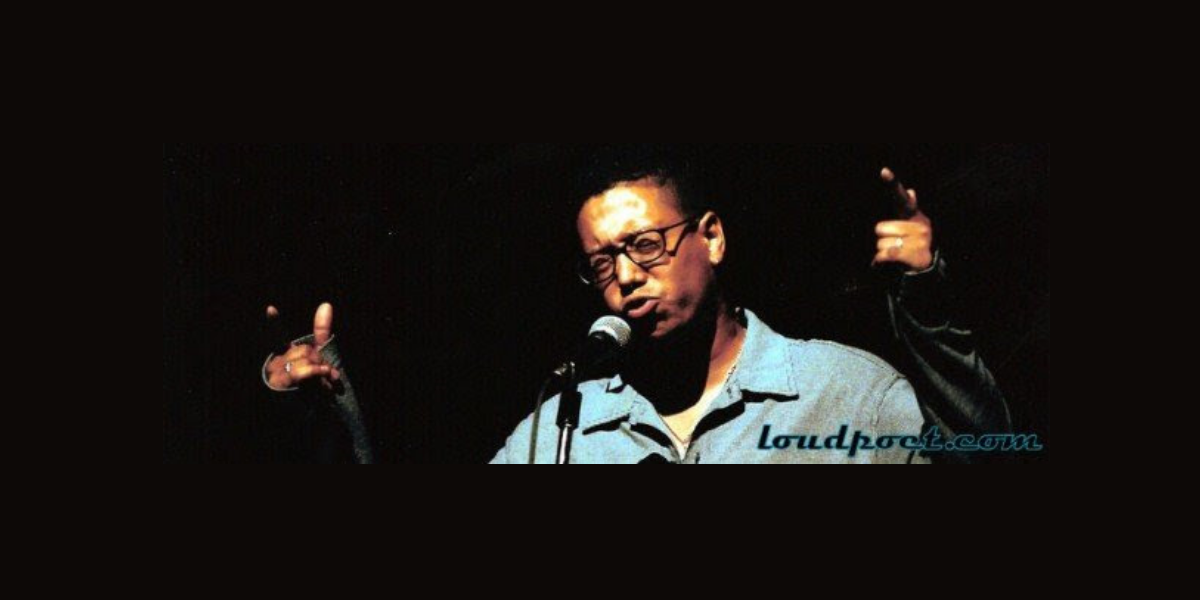NOTE: This article was originally published in POETRY IN AMERICA, Poets & Writers Magazine Special Issue, April 1999, and republished in The Spoken Word Revolution, Redux (Sourcebooks MediaFusion, 2007). It was posted to my old GeoCities site in 1999 and was recovered from the Wayback Machine on 10/29/21. Links to Amazon were replaced, everything else is as originally published.
the Academics have much to
fear
and they will not die
without a dirty fight.
-Charles Bukowski
Faced with the surging popularity of spoken-word and the poetry slam, The Academy of American Poets, long known for its gala reading series, was forced in 1995 to reevaluate its approach to their mission of creating a wider audience for contemporary poetry. “[We] certainly could no longer claim to be an innovator in this regard,” says William Wadsworth, executive director of the Academy. “Looking at how much emphasis was being put on the performance aspect of poetry, I came to feel that it was the Academy’s proper role, as an institution, to do whatever it could to reinforce the book of poems.”
After a year of planning, the Academy launched National Poetry Month in April of 1996. The event rolled into bookstores, all aglow with its mission to “foster an appreciation” for poetry among the masses. In this, its fourth year, bouyed by a media blitz bigger than ever, National Poetry Month claims over 90 sponsoring organizations and promotional tie-ins that include everything from the distribution of 40,000 books of poetry by Volkswagen to this special issue of Poets & Writers Magazine.*
A noble mission, no doubt, but there are many that look on with a smirk and wonder, What took them so long to realize the need for something new?
Fifteen years ago at the Get Me High Lounge in Chicago, Marc Smith, construction worker by day, poet by night, decided he’d had enough of the status quo. He’d grown tired of the stale politeness of the academic poetry reading, where the poet was placed on a pedestal and had no obligations to his audience other than to show up and read poems. His solution: Empower the audience – take poetry down from the tower and not only make it available to the so-called masses, but make it answer to them. Thus was born the poetry slam, a grassroots vehicle for fostering an appreciation for poetry year-round. In the years since, despite often harsh criticism from the academic world, poetry slams have sprung up in nearly every major city and several smaller ones, both here and abroad.
This revolution against the establishment is not unique in the history of poetry. “When Ezra Pound and TS Eliot came along,” says Wadsworth, “there were a lot of poets who thought the world had gone to hell. The values changed. A new generation came along and really changed things. That’s always the case. I’m sure there were poets who were upset when people started writing in English instead of in Latin.”
Since the advent of slams, the spoken-word movement has offended the sensibilities of the establishment on several fronts, not the least of which has been its insistent democratization of the art form. In the slam, anyone can get onstage to read a poem – and the standards of quality rest entriely on the subjective appreciation of randomly chosen members of the audience, who rate poems, Olympic scoring-style, from 0 to 10. Academia’s seal of approval is neither required nor sought.
“Back in Chicago,” remembers Patricia Smith, four-time National Poetry Slam Champion, as well as an award-winning journalist, “there were pundits in the academic world that said [slam] would never last and it would be the death of poetry. [It] began to get a lot of attention, audience and press without being ‘sanctioned.’ No one was able to ‘discover’ slam. It birthed itself. It grew despite no grant money, no kissing ass, not worried about being published…”
Charles Bukowski, arguably one of the most influential antiacademic writers of our century and an honorary “slam” poet, wrote in 1990:
to disrupt this sanctuary
is to them like
the Rape of the Holy Mother.
besides that, it would also
cost them
their wives
their automobiles
their girlfriends
their University
jobs.
The irony was that many of these “slam” poets, were no different than those that saw them as barbarians at the gate. They, too, were the disenfranchised, seeking an opportunity for their voices to be heard.
Brenda Moossy, an MFA student at the University of Arkansas and a successful slam poet and organizer in the Ozarks, always incorporates her work in slams into her classes. “[It] gives permission for people to think outside the box, allows for creative leaps and jumps…lets them see that everyday language and experience are very valuable and, in fact, at the core of what poetry is about.”
“Poetry itself is revolutionary,” says Bob Holman, who went from directing the readings at the St. Mark’s Poetry Project in the late ’70’s in Manhattan to creating the slam scene at New York City’s Nuyorican Poets Café in the early ’90’s. Currently, he’s a Visiting Professor of English at Bard College where he teaches Exploding Text: Poetry in Performance. Holman says, “To write a poem, even to read a poem, to take on all that language can give you is to become an activist. To get the poem to people in this world, you have to utilize the mechanisms that this world provides. I love teaching poetry and performance. I [get] a lot of theoreticians who want to experience experience.”
Of course, none of this is surprising to those who realize that, long before Gutenberg ever gave thought to moveable type, poetry had flourished for centuries as an oral art, and, perhaps most interestingly, as a competitive one.
“In the history of poetry,” says Wadsworth, “a lot of classical or ancient traditions included the same principle, competition between poets; it was judged in one way or another but it was very much like a competitive sport. Slam has roots that go all the way back in the oral tradition.”
And yet, one of the major criticisms of slam is its competitive aspect. Many in academia decry the thought of poems dueling on stage for the approval of an uncredentialed audience. SlamNation, last year’s award-winning documentary of the 1996 National Poetry Slam by ESPN-producer, Paul Devlin, sparked controversy with its tagline: the “Sport of Spoken Word.”
The father of the slam, Marc Smith views such objections as hypocrisy of the highest order. “Poetry in [academia] is competing all the time,” Smith says. “You compete for editor’s approval, for admission, and it’s a closed competition. [There is] more competition in MFA’s, more serious, more cutthroat than there ever could be in the slam world. Most slammers realize [slam is] just a format, a mock-competition, a drama that makes an audience focus its attention.”
Walt Whitman once said, “To have great poets, there must be great audiences.” And the audience is growing. Ten years ago, the first National Poetry Slam was held in San Francisco, California, a one-night event as part of the now-defunct International Poetry Festival. Two teams of poets, from San Francisco and Chicago (with Paul Beatty, an MFA student from Brooklyn College, representing New York), sparred verbally before a crowd of over three hundred people, the festival’s biggest turnout. Last summer, the ninth annual National Poetry Slam in Austin, Texas featured 45 teams of four poets each, from the US and Canada, participating in four nights of non-stop poetry, which culminated in a finale witnessed by a standing-room-only audience of over thirteen hundred people.
Times have changed – the slam has proved itself a viable art form, and many of the poets who got their start there have infiltrated the mainstream. Paul Beatty went from that first National Poetry Slam to publish two well-received volumes of poetry, Big Bank Take Little Bank (Nuyorican Poets Café Press, 1991), and Joker, Joker, Deuce (Penguin, 1994), as well as the critically acclaimed novel White Boy Shuffle (Houghton Mifflin, 1996).
Willie Perdomo, another product of the Nuyorican Poets Café, had his debut collection of poems, Where a Nickel Costs a Dime (which included a Performance CD), published by W.W. Norton in 1996.
Poetry Nation: the North American Anthology of Fusion Poetry (Véhicule Press, 1999), edited by performance poets Regie Cabico and Todd Swift, was published in February, and includes work by “slam” poets Patricia Smith, Jeff McDaniel and Beau Sia alongside Allen Ginsberg, Miguel Algarin and Denise Duhamel.
And Poets & Writers, Inc., through its Readings & Workshops programs, has funded many slam poets and events in New York, California, Detroit and Chicago.
“Like it or not,” says Wadsworth, “this is what’s going to bring this art form into the 21st century. I think it’s the creation of a new genre, the creation of a new music. How it evolves will be very interesting.”
Bukowski put it this way:
we have come from the alleys
and the bars and the
jails
we don't care how they
write the poem
but we insist that there are
other voices
other ways of creating
other ways of living the
life
and we intend to be
heard and heard and
heard
in this battle against the
Centuries of the Inbred
Dead
let it be known that
we have arrived and
intend to
stay.
On the verge of its 10th-Anniversary, the National Poetry Slam will return to its birthplace in Chicago, bigger than ever, and Smith is preparing a homecoming that will further imprint his vision on the slam. “Every revolution becomes an institution. Though it’s being adopted in academia, the main movement is still very radical. It’s still fresh and evolving. The mission isn’t anywhere near completed.”
That mission – making poetry accessible, providing a platform for all voices to be heard – is one that will not take place in the aisles of your local mega-bookstore one month a year. It will not be sponsored by Nike, Sprite or MTV. It is not wedded to the elitist posturings of academics holding on to their tenures for dear life. It is a year-round process that is happening in coffeehouses and bars and community centers throughout the world. The revolution will happen and, for once, the victory will not be posthumous.
**Includes excerpts from Charles Bukowki’s “the Rape of the Holy Mother,” Septuagenarian Stew: Stories & Poems (Black Sparrow Press, 1990).
Do you like email?
Sign up here to get my bi-weekly "newsletter" and/or receive every new blog post delivered right to your inbox. (Burner emails are fine. I get it!)


